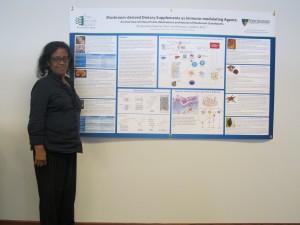 In the past weeks, two important papers have been published which were intended to advance the understanding of the role of carnitine in human health (or disease). The one, which appears to suggest carnitine is potentially harmful, you might already know about; the other, which shows the repeated benefit of carnitine, you may not have heard about (yet). We will attempt to synthesize the information in these two papers (along with some background information) to see if we can come to a reasonable understanding of the role of carnitine as a dietary supplement. A brief “Final Point” can be found at the end.
In the past weeks, two important papers have been published which were intended to advance the understanding of the role of carnitine in human health (or disease). The one, which appears to suggest carnitine is potentially harmful, you might already know about; the other, which shows the repeated benefit of carnitine, you may not have heard about (yet). We will attempt to synthesize the information in these two papers (along with some background information) to see if we can come to a reasonable understanding of the role of carnitine as a dietary supplement. A brief “Final Point” can be found at the end.
First of all, for those less familiar with carnitine; it is an amino acid-like compound which our bodies can synthesize from the amino acids lysine and methionine. Natural sources of carnitine come primarily from red meat and dairy, although lesser amounts can be found in a variety of foods such as fish, nuts, tempeh and avocados. Its main biological function is to help transport acyl-groups from fatty acids into mitochondria where they can be used as energy for the cell (via beta-oxidation). As a dietary supplement, L-carnitine has been used primarily for heart conditions, male fertility, sperm health, weight loss and energy.
The first paper we will discuss was published in Nature Medicine from the prestigious group at the Cleveland Clinic. This was an ambitious project and paper- covering a wide range of experiments in both human and animal subjects. The title itself is a bit provocative: “Intestinal microbiota metabolism of L-carnitine, a nutrient in red meat, promotes atherosclerosis”, immediately tying this research with red meat consumption and risk for heart disease. Needless to say it has set off a number of debates- some of which I will point you to throughout the rest of this brief discussion.
What they reported was essentially that certain bacteria in our gut can convert carnitine (and other compounds) into a molecule called TMA (trimethylamine), which can be further converted by our liver to TMAO (trimethylamine oxide). TMAO has been shown in other studies to increase the risk for atherosclerosis. Further, they found that in vegetarians (at least those they tested) conversion of carnitine (from beef or supplements) was not converted to TMA because the bacteria required for the conversion are not abundant enough to allow for this conversion. No TMA- no conversion to TMAO- and therefore a reduced atherosclerotic risk (-or so the logic is assumed). They also showed that in a large number of patients coming in for voluntary cardiac evaluation- those with the highest levels of blood carnitine had a higher calculated risk for certain cardiovascular events. The researchers also conducted several studies in mice which were fed carnitine and they found consistent changes in the gut microbiota- allowing for selectively more carnitine to TMA conversion.
The paper, at first, seems to be airtight and quite convincing; until you really begin to look at the details of each experiment and the broader question of the role of TMAO in the diet. Since there is an extremely detailed discussion of these issues and critiques of this paper at the Weston Price Foundation Website online (not for the scientific faint of heart), I will just give you the gist of it here.
- To focus on “red meat” and carnitine in particular as notable substrates for the generation of TMAO in humans is odd when previous studies have shown that serum TMAO is much higher in subjects after the consumption of numerous vegetable and greatly increased (up to 100X) when consuming certain types of seafood. The authors even say “An analyte with identical molecular weight and retention time to L-carnitine was not in the top tier of analytes that met the stringent P value cutoff for association with CVD. However, a hypothesis-driven examination of the data using less stringent criteria (no adjustment for multiple testing) revealed an analyte with the appropriate molecular weight and retention time for L-carnitine that was associated with cardiovascular event risk (P=0.04).”[emphasis added] One might ask why their hypothesis-driven examination focused on a relatively low TMAO inducing agent with no association with CVD which happens to be in red meat.
- Much of the data between vegetarian and omnivore subjects were dependent on few, and in some cases, single individuals. Apparently convincing vegetarians to consume meat was more challenging than they initially figured. Some of this data is, at best, hypothesis generating- but is far from conclusive. These issues are further complicated since the gender of the vegetarian and the omnivore were different and there is known sex-based differences in the enzyme activities which form TMAO in humans. Since diet is very important to the formation of the human gut bacteria environment, I don’t doubt there may be significant differences in the microbiota between vegetarians and omnivores/carnivores- even in their ability to convert carnitine into TMA. It may also be that other beneficial compounds made by these same organisms would be absent or diminished in vegetarians- limiting other benefits derived from carnitine.
- The mouse studies, again, are very interesting and should be the basis of future studies but the ability to translate these results to humans is very tenuous at best. By anyone’s calculations, the amount of carnitine given to these mice greatly exceeds the doses which could be consumed by humans eating meat or by supplementation. Likewise, the changes in microbiota in mice which resulted from carnitine consumption is difficult to contextualize since as the authors tell us “Notably, a direct comparison of taxa associated with plasma TMAO concentrations in humans versus in mice failed to identify common taxa. These results are consistent with prior reports that microbes identified from the distal gut of the mouse represent genera that are typically not detected in humans” I am guessing we will see follow-up studies in humans.
- Finally, the authors report two relationships between blood carnitine levels and risk for cardiovascular disease. In one data set- they report that the predicted risk is higher at the highest blood level of carnitine; however when they actually correlated fasting carnitine levels with known major adverse cardiac events over a 3-year period (adjusted for comorbidities and traditional risk factors) there was no increased incidence of events (see discussion on Mayo Clinic paper below).
Again- further details on these and other finer points can be found at the Weston Price Foundation’s online discussion of this paper for those interested. The Cleveland Clinic group has certainly illuminated us on the role of intestinal microbiota in the conversion of food substances and potential health outcomes (this is likely to be a huge area of future research on bioactives in food and supplement in the next decade) – but this data is not sufficient yet to demonstrate that red meat or the carnitine it delivers contributes to the risk of heart disease in humans.
Now, on to the second big carnitine paper from last week (the one you may not have heard about yet). This paper was published in the Mayo Clinic Proceedings and is a systematic review and meta-analysis of a number of clinical trials published since the mid-1980’s using L-carnitine as a supplement. Specifically, since myocardial carnitine levels are quickly diminished during ischemic events (like an MI), they looked at only those studies which used L-carnitine supplements (compared to placebo) in individuals with a previous acute myocardial infarction (AMI). The studies that met their criteria looked at outcomes like all-cause mortality, ventricular arrhythmias, myocardial reinfarction, heart failure or angina. In all, 13 studies met there criteria for evaluation which included 3629 patients. In their statistical analysis, L-carnitine consumption was associated with a 27% reduction in all-cause mortality, a 65% reduction in ventricular arrhythmias, and a 40% reduction in angina symptoms compared to placebo in these post-AMI patients. A non-statistical trend toward reduced risk was seen with both heart failure and myocardial reinfarction.
As anyone who has reviewed meta-analysis data can tell you, these types of analysis are far from definitive evidence for (or against) a particular therapy. Different doses were used, different routes of administration and slightly different outcomes measured always makes the pooling of data from experiments performed over several decades for statistical analysis less than perfect; this study is no exception. Also, like many other dietary supplement trials-many of those selected for this meta-analysis were small trials.
Individually, while many of these studies did not reach statistical significance for some of the outcome measurements, in nearly every case, the benefit clearly favored carnitine over the placebo. Pooling the data increases the statistical significance, but it did not change the clear benefit from these studies. In fact, only one measurement in a single study (a 1995 study looking at reinfarction) showed a benefit for the placebo group (albeit non-statistical) which was enough to prevent the overall benefit in the pooled data for this measurement.
As always they suggest (and we agree) that more studies (larger, better) be performed to assess the role of L-carnitine as a supplement for post-AMI patients (and other cardiovascular outcomes). What we can say from these data is there appears to be no harm in using L-carnitine in patients for secondary prevention of cardiovascular disease- and a strong likelihood of benefit. Certainly, future studies will likely address TMAO production in light of the Cleveland Clinic study above. It may be possible to discover a relationship between certain intestinal microbiota which enhance or diminish the use of L-carnitine as a bioactive agent.
While I don’t have time to add more here- check these recent papers for more about the use of carnitine (as a supplement):
- Metabolic Effects of L-carnitine on Type 2 Diabetes Mellitus: Systematic Review and Meta-analysis. Exp Clin Endocrinol Diabetes. 2013 Feb 21.
- A systematic review to evaluate the effectiveness of carnitine supplementation in improving walking performance among individuals with intermittent claudication. Atherosclerosis. 2013 Mar 15
Final Point: Q&A
Q: Should we avoid or limit the use of L-carnitine in foods or supplements in order to avoid the potential risk for cardiovascular disease?
A: There is no evidence that avoiding carnitine will reduce CVD. If we are convinced that the formation of TMAO is a leading cause of atherosclerosis (I’m not yet), the conversion from carnitine to TMAO is a minor contributor even at extremely high supplemental (or dietary) levels; furthermore, individuals with cardiovascular disease appear (from the Mayo Clinic paper) to be protected from secondary events when using supplemental carnitine; a finding which shows that higher doses are more protective.
Q: Is Red Meat Bad for your health?
A: This is a much bigger topic than we can cover here and, of course, very controversial. Our position is that the majority of the risks associated with meat can be attributed to processed meat consumption, certain cooking methods for meat (frying, charring etc.) and the fact that many people who eat meat also have a wide-range of poor eating patterns (low fruit and vegetable consumption, low consumption of good fats, increased use of potatoes, breads and refined sugars etc.). Within the background of a prudent diet (like the Mediterranean diet), red meat, poultry and fish should not increase risk for chronic disease.
Q: Are there probiotics that can be taken which will reduce/eliminate the conversion of carnitine or other substances to TMA in our GI tract?
A: We don’t know yet. Certainly this type of research will be conducted in the future as the role of probiotics in a wide-range of health conditions are being explored. My guess is that we will, over the next decade or so, find specific blends of probiotics which may sufficiently modulate the GI microbiota to compensate for many disease-related conditions.
[Image courtesy of piyato / FreeDigitalPhotos.net]


 Losing weight is always difficult, but what if extra fat may be the body’s only defense from dangerous fat-soluble toxins? Remember the adage: “The solution to pollution is dilution”- we attempt to dilute poisons to reduce their concentration and therefore, their toxic effects. In the case of fat-soluble toxins, many compounds actually trigger the body to produce fat as a protective storage for these additional toxins. This keeps the toxins away from sensitive tissues and cells, but increases body fat and weight which can lead to other serious concerns.
Losing weight is always difficult, but what if extra fat may be the body’s only defense from dangerous fat-soluble toxins? Remember the adage: “The solution to pollution is dilution”- we attempt to dilute poisons to reduce their concentration and therefore, their toxic effects. In the case of fat-soluble toxins, many compounds actually trigger the body to produce fat as a protective storage for these additional toxins. This keeps the toxins away from sensitive tissues and cells, but increases body fat and weight which can lead to other serious concerns.